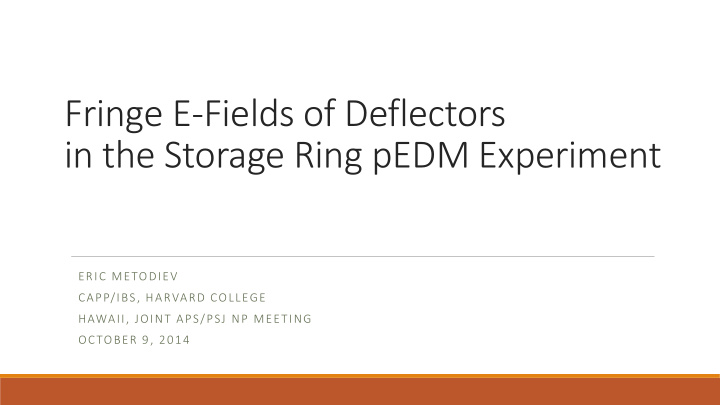



Fringe E-Fields of Deflectors in the Storage Ring pEDM Experiment ERIC METODIEV CAPP/IBS, HARVARD COLLEGE HAWAII, JOINT APS/PSJ NP MEETING OCTOBER 9, 2014
The Storage Ring pEDM Experiment Target sensitivity of 10 −29 𝑓. cm to 10 −30 𝑓. cm. Spin precession physics similar to those in the Muon (g-2). The systematics of the Storage Ring pEDM are very different from the Muon (g-2) experiment and from other EDM experiments.
The basic idea Protons circulate in ring at their magic momentum, with their spin vectors frozen along their momentum of 0.7 GeV/c. Spin precession out of the plane indicates an EDM. This assumes: • The electric fields are always radial • There is no electric field outside of the deflectors This is not quite true! We want to use precision tracking to see what the realistic effects are.
Treatments of fringe fields As a first approximation: Hard Edge Numerical simulations
Treatments of fringe fields As a first approximation: Hard Edge Numerical simulations • Must recalculate the potential if • Easy to deal with analytically and the plate spacing or radius of the to implement in simulations. ring changes. • During R&D, several ring • The hard edge approximation is geometries and sizes are not a solution to Maxwell’s considered, and all must be equations. simulated. • Is an intuitive approximation, but • Can be relatively difficult to may not be very accurate. implement in tracking simulations.
Questions to answer Are the particles stable when we consider fringe fields? Do the fringe fields affect the spin dynamics to our sensitivity? Are there ways to cancel the fringe effects and deflections?
Analytical Solution consistent with Maxwell For a semi-infinite cylindrical plates, we can find an analytic solution. In terms of implicitly defined coordinates u, v: The potential is then V = V0 v/pi. After some work, this can be inverted to:
Our implementation The approximation: we take the deflector sections to be far enough apart, so we added together the analytical solutions for each section. ◦ This is still a solution to Maxwell, just for a slightly different geometry. ◦ We found that this was a good approximation to our sensitivity. ◦ Much better approximation than hard edge. ◦ Will conserve energy in precision tracking.
Tracking As a proof of concept, we used a fourth order Runge-Kutta integrator with a step size of 1ps.
Tracking We implemented a model of the pEDM ring, using realistic fringe fields:
Results Particles are stable with a suitable The spin dynamics of the change of geometry! particles were not distinguishable to our Their paths deviate from the hard- sensitivity from the same edge orbits by less than millimeters. particles in a hard edge approximation. The aperture of the ring is very slightly affected. There is a slight radial deflection due to the fringes
Possible Changes to the Experiment There are two possible changes to the experimental geometry to correct for the deflection due to the fringes: ◦ Shorten the deflectors by several millimeters. ◦ Change the radius of curvature of the deflectors.
Possible Changes to the Experiment The possible alterations to the geometry have been studied. The deflection can be compensated by appropriately shortened electrodes. • These have been studied for a variety of possible bending radii and plate spacings Without the slight change in the geometry, the particles were actually found to not be stable in the ring!
Some specifics We developed a set of tools to deal with fringe fields and allow them to naturally be incorporated in precision tracking programs. ◦ The vertical dimension was neglected in treating the problem. There are fringe fields in this direction as well, but they do not treat the directions asymmetrically, as the horizontal fringe fields do. ◦ Other horizontal and vertical focusing (such as due to quads) was left out of the analysis. We investigated whether the lattice was stable in the ideal case, and we found that slight modifications were necessary.
Bottom line With realistic analytical estimates of the fringe electric fields in the pEDM deflectors, using precision tracking we have shown: ◦ The particles are stable inside the ring, accounting for fringe fields ◦ The spin dynamics are not significantly altered ◦ Very small changes to the deflector geometry can further cancel the effects
The End Thank you! Questions? For more detail see Metodiev, et al. PRSTAB, 2014.
Additional Slides
Additional Slides
Recommend
More recommend